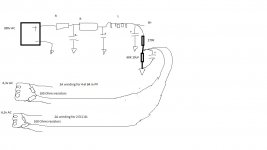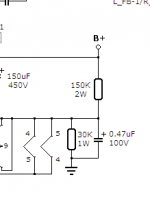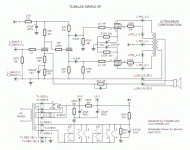Although I don't know everything...
Gonna go out on a limb here and say absolutely not.
Use the 6.3V winding which should be available w/ any correct tube amp PT... (power transformer)
Jim
Gonna go out on a limb here and say absolutely not.
Use the 6.3V winding which should be available w/ any correct tube amp PT... (power transformer)
Jim
1. I would not bother elevating the EL84 heaters.
Because . . .
The cathodes are most likely only 1 0r 10 Ohms away from ground (a current sense resistor, if Fixed Adjustable Bias for g1 is used).
Or . . .
The cathodes are approximately 150 to 300 Ohms away from ground, But a bypass cap is wired across the Self Bias Resistor, and they both connect to ground (hopefully the bypass capacitor's impedance value is very low at 20Hz).
If you use either of the above two methods, if the EL84 is Actually and Really the cause of any measurable hum, then remove that EL84 and crush it (nobody wants to use an EL84 that has a filament to cathode leakage that is that bad).
2. The circuit for the ECC81 looks good . . .
Except, you may have to adjust the B+ voltage divider, so that any and all cathodes voltages, and elevated filaments meet the ECC81 filament to cathode specs.
* That includes the DC voltage on the Cathodes; and any Signal peak voltage swing on the cathodes such as in an SRPP stage, or a Concertina Phase Splitter, or a Cathode follower, and do not forget the bottom un-bypassed cathode voltage of the SRPP too.
If all you have is a single ECC81 triode (with self bias resistor and bypass cap, both connected to ground) driving a single EL84 in one channel,
and the other ECC81 triode the same in the other channel, you probably do not need an elevated filament.
There is not a lot of gain in that simple single ended amplifier (unless you are going to use it as a headphone amp, headphones are Very sensitive;
or unless you are doing near field listening to a horn speaker with 104dB sensitvity; but such horns do not sound good that close).
For un-bypassed cathodes as in * above, you quite possibly will need a elevated filament.
For bypassed cathodes, and any hum resulting in spite of the fact that they are bypassed, I would question whether you want to crush the ECC81 or use an elevated heater supply.
And when the filament to cathode becomes leaky, is it equally leaky from both phases of the 6.3v? Maybe not, so then you get Hummmm.
The secret is to use good tubes.
By the Way, I purchase JJ ECC81 at Eurotubes.com They re-test the tubes after they come from the manufacturer (some tests are for noise, and I believe filament to cathode leakage is tested too).
The JJ ECC81 uses Spiral Wound Filaments (equal voltage UP, and equal voltage Down, but of opposite phase).
They do not use the simple up, down, up, down, . . . filaments that most manufacturers use.
Food for thought.
"You should make things as simple as possible, but no simpler" - Albert Einstein
Because . . .
The cathodes are most likely only 1 0r 10 Ohms away from ground (a current sense resistor, if Fixed Adjustable Bias for g1 is used).
Or . . .
The cathodes are approximately 150 to 300 Ohms away from ground, But a bypass cap is wired across the Self Bias Resistor, and they both connect to ground (hopefully the bypass capacitor's impedance value is very low at 20Hz).
If you use either of the above two methods, if the EL84 is Actually and Really the cause of any measurable hum, then remove that EL84 and crush it (nobody wants to use an EL84 that has a filament to cathode leakage that is that bad).
2. The circuit for the ECC81 looks good . . .
Except, you may have to adjust the B+ voltage divider, so that any and all cathodes voltages, and elevated filaments meet the ECC81 filament to cathode specs.
* That includes the DC voltage on the Cathodes; and any Signal peak voltage swing on the cathodes such as in an SRPP stage, or a Concertina Phase Splitter, or a Cathode follower, and do not forget the bottom un-bypassed cathode voltage of the SRPP too.
If all you have is a single ECC81 triode (with self bias resistor and bypass cap, both connected to ground) driving a single EL84 in one channel,
and the other ECC81 triode the same in the other channel, you probably do not need an elevated filament.
There is not a lot of gain in that simple single ended amplifier (unless you are going to use it as a headphone amp, headphones are Very sensitive;
or unless you are doing near field listening to a horn speaker with 104dB sensitvity; but such horns do not sound good that close).
For un-bypassed cathodes as in * above, you quite possibly will need a elevated filament.
For bypassed cathodes, and any hum resulting in spite of the fact that they are bypassed, I would question whether you want to crush the ECC81 or use an elevated heater supply.
And when the filament to cathode becomes leaky, is it equally leaky from both phases of the 6.3v? Maybe not, so then you get Hummmm.
The secret is to use good tubes.
By the Way, I purchase JJ ECC81 at Eurotubes.com They re-test the tubes after they come from the manufacturer (some tests are for noise, and I believe filament to cathode leakage is tested too).
The JJ ECC81 uses Spiral Wound Filaments (equal voltage UP, and equal voltage Down, but of opposite phase).
They do not use the simple up, down, up, down, . . . filaments that most manufacturers use.
Food for thought.
"You should make things as simple as possible, but no simpler" - Albert Einstein
Last edited:
Post the schematic of the amp, with al the pertinent voltages. The correct answer depends on that. We need to see if/why all of your filaments need to be elevated and to what voltage.
El 84 PP
The amp I am going to build is a clone of the Tubelab Simple pp. Have 235v from the sockets in my appartment, and the power transformer are made for 220v primary voltage, so thats why I use some voltage drop-resistors. I will probably use some voltage drop resistors in the heater windings too? The capacity for the heater winding for the four power tubes, el 84, are 3A, and thats why I have to use another heater winding for the input tubes. On the original schematics there are one 150K resistor and one 30K in the elevator curcuit, and the values I drawed are probably wrong ?
The amp I am going to build is a clone of the Tubelab Simple pp. Have 235v from the sockets in my appartment, and the power transformer are made for 220v primary voltage, so thats why I use some voltage drop-resistors. I will probably use some voltage drop resistors in the heater windings too? The capacity for the heater winding for the four power tubes, el 84, are 3A, and thats why I have to use another heater winding for the input tubes. On the original schematics there are one 150K resistor and one 30K in the elevator curcuit, and the values I drawed are probably wrong ?
Attachments
Last edited:
My EL84 amp uses 6EU7 input/ps tubes (6V version of 12AX7) and runs on the same AC (with a 700 ohm hum pot) as the outputs, and yet, with no signal, the amp is utterly silent.
So if properly built, I see no temptation to be bothered with DC on filaments.
Because that is usually reserved for phono preamp duty.
So if properly built, I see no temptation to be bothered with DC on filaments.
Because that is usually reserved for phono preamp duty.
stenak:
The ECC81 has Vmax h-k of +/-90V, so you will likely have to elevate the heater to a voltage somewhere between the 2 cathodes. The EL84 has a max of +/-200V so it's not necessary to elevate the cathode. And if you do, it would be to a much smaller voltage.
The ECC81 has Vmax h-k of +/-90V, so you will likely have to elevate the heater to a voltage somewhere between the 2 cathodes. The EL84 has a max of +/-200V so it's not necessary to elevate the cathode. And if you do, it would be to a much smaller voltage.
Not sure you need to elevate any heater windings there. No voltages are shown on the schematic but for a EL84 amp a HT of about 300v is usual, say 250v ish for the pre and PS stages, that should put your ECC81 PS cathode at about 70v ish, within the 90v Vhtr/k specs. Not ideal, but still.
If you do elevate the ECC81 heaters why not use the values of the potential divider given on the schematic? One last thought, a 500r pot or similar would be preferable to fixed R's on the heaters, makes a big difference in my experience.
Andy.
If you do elevate the ECC81 heaters why not use the values of the potential divider given on the schematic? One last thought, a 500r pot or similar would be preferable to fixed R's on the heaters, makes a big difference in my experience.
Andy.
The amp I am going to build is a clone of the Tubelab Simple pp.
If you are cloning that amp then there is heater elevation for the ECC81, so just clone that part of the schematic too.
I probably clone this amp, but I have two heater windings and my question was, is it ok to do like my drawing(I know it`s a horrble one!) says? To elevate the heater winding to the ecc 81? I will use the same resistor values you see on the schematic.
wiseoldtech:
This thread is not about DC on filaments.
It's about elevating filament potential using the B+/DC supply.
And as others have mentioned, there's no need for such an arrangement in a power amp, other than perhaps using a hum pot.
Surely, the 12AT7 is seeing far less than the 300V supply after the L/C/R network, so why complicate things?
I've never seen a problem with traditional design as has been for decades.
I've built a couple of SPP amps. Worked great! Choke in B+ supply recommended to get rid of last bit of hum. Your 260v AC supply might run a bit high once rectified to DC. My advice: Add some resistors in the primary side if necessary to keep EL84 filaments at or below 6.3 volts. If B+ is high add some more resistance to in B+ supply. I'd float the ECC81 as per the SPP circuit. Connect one side of EL84 to ground or float with ECC81s as required for lowest hum. Connect the amp to chassis ground near the input of the circuit, that worked for me. I also found that I needed to increase the EL84 cathode resistance a bit from the schematic value to keep the power dissipation of the tubes a bit below max. This applies especially to JJ EL84s. Russian tubes can handle a bit higher dissipation.
Steve
Steve
- Home
- Amplifiers
- Tubes / Valves
- EL 84pp power supply


